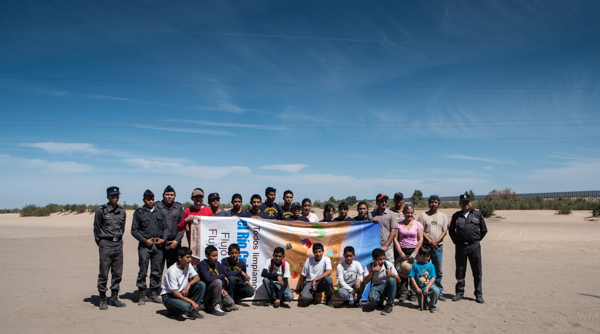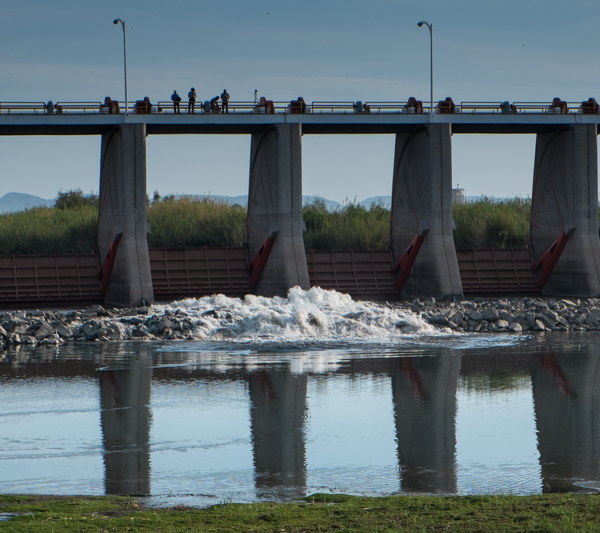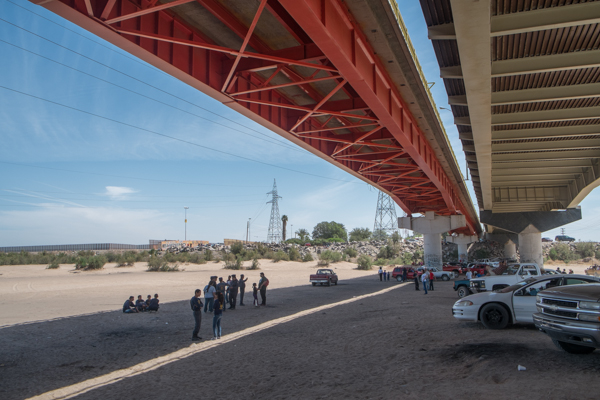SAN LUIS RIO COLORADO – Manuel Campa was very particular. His town’s name is often shortened to merely “San Luis”, but standing in the dry bed of the Colorado River this morning, the full name mattered very much. “It’s the only city that has the name ‘Rio Colorado,'” he said.
The sandy riverbed beneath the bridge just west of town has become an iconic, sad image of the drying of the Colorado River. Since Hoover and Glen Canyon dams corralled the river’s flow for human use, the once-great river at San Luis has been slowly but surely dried until just a bed of sand remains.
But this morning the riverbed felt more like a party than an icon. A couple hundred area residents were out with Campa for a community riverbed cleanup, and to await the water. Around 8:15 a.m., 22 miles upstream, one of the middle gates on Morelos Dam inched up and a froth of water gushed through, part of an experimental “pulse flow” to use the Colorado’s plumbing to mimic, in some small measure, the flow that once made this not only one of the planet’s estuarial ecosystems, but also gave places like San Luis their cultural identity.
It’s not clear how soon the first water will reach San Luis – probably not for a couple more days. But that didn’t dampen the festivities this morning as pickups and Harleys and families with soccer balls and four-wheelers turned the shady stretch under the bridge into an impromptu festival rio. “They want to see the water,” Waldo Medina explained.
I asked Medina, who kindly served as translator for a monolingual norteño, when San Luis had last seen water in the Rio Colorado. “1998,” he said. What struck me was how he said it without hesitation, and what that suggests about the longing for water. Without pause, he knew exactly how long the rio has been dry. (update: An emailer points out, with data to back it up, that “1998” is incorrect, and that there have been a number of flows past San Luis Rio Colorado since that time. I’ve got the data, and once I get the handy dandy graph made, I’ll put up a new post. update 2: Here’s the data showing that the river has, in fact, flowed a number of times since 1998 at San Luis.)
I’m going to invoke the blogger’s prerogative to revise and extend my remarks here at a later time, because the language barrier made this a tough conversation, but Medina worked hard to explain to me the idea of “la cuenca” – the area of the delta where both waters – the river water from the north, the seawater from the south, meet. “La cuenca is dead right now,” Medina said.
A friend pulled out a iPhone and began scrolling up and down a satellite map of the area, a mix of green of farms and brown of desert. “All this a long time ago was the river,” Medina explained.
“The water is very important for the life,” Medina said. “All people living around the Colorado River, they need the water.”




Pingback: Memories of water | jfleck at inkstain
Pingback: Bloggers on the Fresno field hearing, the ongoing drought, salinity in the Delta, conservation, hyacinth, and more » MAVEN'S NOTEBOOK | MAVEN'S NOTEBOOK
Pingback: A pickup, stuck in the Colorado River sand | jfleck at inkstain